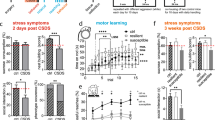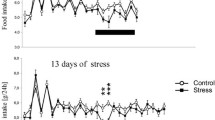Abstract
Social stress is viewed as a factor in the etiology of a variety of psychopathologies such as depression and anxiety. Animal models of social stress are well developed and widely used in studying clinical and physiological effects of stress. Stress is known to significantly affect learning and memory, and this effect strongly depends on the type of stress, its intensity, and duration. It has been demonstrated that chronic and acute stress conditions can change neuronal plasticity, characterized by retraction of apical dendrites, reduction in axonogenesis, and decreased neurogenesis. Various behavioral studies have also confirmed a decrease in learning and memory upon exposure of animals to long-term chronic stress. On the other hand, the close relationship between microtubule (MT) protein network and neuroplasticity controlling system suggests the possibility of MT protein alterations in high stressful conditions. In this work, we have studied the kinetics, activity, and dynamicity changes of MT proteins in the cerebral cortex of male Wistar rats that were subjected to social instability for 35 and 100 days. Our results indicate that MT protein network dynamicity and polymerization ability is decreased under long-term (100 days) social stress conditions.




Similar content being viewed by others
References
Bianchi M, Fone KFC, Azmi N, Heidbreder CA, Hagan JJ, Marsden CA (2006) Isolation rearing induces recognition memory deficits accompanied by cytoskeletal alterations in rat hippocampus. Eur J Neurosci 24(10):2894–2902
Bianchi M, Hagan JJ, Heidbreder CA (2005) Neuronal plasticity, stress and depression: involvement of the cytoskeletal microtubular system?, vol 4. Bentham Science Publishers, pp 597–611
Bianchi M, Heidbreder C, Crespi F (2003) Cytoskeletal changes in the hippocampus following restraint stress: role of serotonin and microtubules. Synapse 49(3):188–194
Blanchard DC, McKittrick CR, Hardy MP, Blanchard RJ (2002) Effects of social stress on hormones, brain, and behavior vol 1, pp 735–772
Blanchard RJ, McKittrick CR, Blanchard DC (2001) Animal models of social stress: effects on behavior and brain neurochemical systems. Physiol Behav 73(3):261–271
Dadras A, Riazi GH, Afrasiabi A, Naghshineh A, Ghalandari B, Mokhtari F (2013) In vitro study on the alterations of brain tubulin structure and assembly affected by magnetite nanoparticles vol 18. Springer, pp 357–369
Diamond DM, Bennett MC, Fleshner M, Rose GM (1992) Inverted‐U relationship between the level of peripheral corticosterone and the magnitude of hippocampal primed burst potentiation. Hippocampus 2(4):421–430
Falnikar A, Baas PW (2009) Critical roles for microtubules in axonal development and disease Cell Biology of the Axon. Springer, pp 47–64
Glanz K, Schwartz MD (2008) Stress, coping, and health behavior. Health behavior and health education: theory, research, and practice. 4th edition. San Francisco (CA): John Wiley and Sons, Inc, 211–236
Hameroff SR, Watt RC (1982) Information processing in microtubules, vol 98. Elsevier, pp 549–561
Jibu M, Hagan S, Hameroff SR, Pribram KH, Yasue K (1994) Quantum optical coherence in cytoskeletal microtubules: implications for brain function. Biosystems 32(3):195–209
Krugers HJ, Alfarez DN, Karst H, Parashkouhi K, van Gemert N, Joëls M (2005) Corticosterone shifts different forms of synaptic potentiation in opposite directions. Hippocampus 15(6):697–703
Mahdi Dust S, Mahdavi Vaez, Mohammad R, Kabudanian Ardestani S, Sedaghat R, Jalilvand F, . . . Arbab Soleymani S (2013) Effect of stress due to food deprivation, social inequality and instability on brain. Physiol Pharmacol. vol 16, pp 350–359
Meshkini A, Yazdanparast R, Nouri K (2011) Intracellular GTP level determines cell’s fate toward differentiation and apoptosis, vol 253. Elsevier, pp 188–196
Miller HP, Wilson L (2010) Preparation of microtubule protein and purified tubulin from bovine brain by cycles of assembly and disassembly and phosphocellulose chromatography, vol 95, pp. 1–13
Moradi F, Mahdavi MRV, Ahmadiani A, Rogani M, Altiraihi T, Mojarab S (2012) Can social instability, food deprivation and food inequality accelerate neuronal aging? (vol 3)
Nogales E (2000) Structural insights into microtubule function. Annu Rev Biochem 69(1):277–302
Ohl F, Fuchs E (1998) Memory performance in tree shrews: effects of stressful experiences. Neurosci Biobehav Rev 23(2):319–323
Ohl F, Fuchs E (1999) Differential effects of chronic stress on memory processes in the tree shrew. Cogn Brain Res 7(3):379–387
Qian A, Burton PR, Himes RH (1993) A comparison of microtubule assembly in brain extracts from young and old rats,vol 18. Elsevier, pp 100–106.
Radley JJ, Morrison JH (2005) Repeated stress and structural plasticity in the brain, vol 4. Elsevier, pp 271–287
Radley JJ, Sisti HM, Hao J, Rocher AB, McCall T, Hof PR, Morrison JH (2004) Chronic behavioral stress induces apical dendritic reorganization in pyramidal neurons of the medial prefrontal cortex. Neuroscience 125(1):1–6
Sapolsky RM (2005) The influence of social hierarchy on primate health. Am Assoc Adv Sci 308:648–652
Siegel SJ, Ginsberg SD, Hof PR, Foote SL, Young WG, Kraemer GW, Morrison JH (1993) Effects of social deprivation in prepubescent rhesus monkeys: immunohistochemical analysis of the neurofilament protein triplet in the hippocampal formation. Brain Res 619(1):299–305
Sousa N, Cerqueira JJ, Almeida OFX (2008) Corticosteroid receptors and neuroplasticity, vol 57. Elsevier, pp 561–570
Stephens RE, Edds KT (1976) Microtubules: structure, chemistry, and function. Physiol Rev 56(4):709–777
Tucker RP (1990) The roles of microtubule-associated proteins in brain morphogenesis: a review. Brain Res Rev 15(2):101–120
Tucker RP, Garner CC, Matus A (1989) In situ localization of microtubule-associated protein mRNA in the developing and adult rat brain. Neuron 2(3):1245–1256
Tuszy Å, ski JA, Hameroff S, Satarić MV, Trpisova B, Nip MLA (1995) Ferroelectric behavior in microtubule dipole lattices: implications for information processing, signaling and assembly/disassembly, vol 174. Elsevier, pp 371–380
Vollmann-Honsdorf GK, Flügge G, Fuchs E (1997) Chronic psychosocial stress does not affect the number of pyramidal neurons in tree shrew hippocampus. Neurosci Lett 233(2):121–124
Williams Jr RC, Lee JC (1981) Preparation of tubulin from brain, vol 85. pp 376–385
Xu H, He J, Richardson JS, Li X-M (2004) The response of synaptophysin and microtubule‐associated protein 1 to restraint stress in rat hippocampus and its modulation by venlafaxine. J Neurochem 91(6):1380–1388
Yang C, Wang G, Wang H, Liu Z, Wang X (2009) Cytoskeletal alterations in rat hippocampus following chronic unpredictable mild stress and re-exposure to acute and chronic unpredictable mild stress, vol 205. Elsevier, pp 518–524)
Author information
Authors and Affiliations
Corresponding author
Rights and permissions
About this article
Cite this article
Eskandari Sedighi, G., Riazi, G.H., Vaez Mahdavi, M.R. et al. Chronic, Long-Term Social Stress Can Cause Decreased Microtubule Protein Network Activity and Dynamics in Cerebral Cortex of Male Wistar Rats. J Mol Neurosci 55, 579–586 (2015). https://doi.org/10.1007/s12031-014-0394-4
Received:
Accepted:
Published:
Issue Date:
DOI: https://doi.org/10.1007/s12031-014-0394-4




